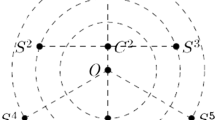Abstract
A new principle for performing polychotomous classification with pairwise classifiers is introduced: if pairwise classifier \( \mathcal{N}_{ij} \), trained to discriminate between classes i and j, responds “i” for an input x from an unknown class (not necessarily i or j), one can at best conclude that x ∉ j. Thus, the output of pairwise classifier \( \mathcal{N}_{ij} \) can be interpreted as a vote against the losing class j, and not, as existing methods propose, as a vote for the winning class i. Both a discrete and a continuous classification model derived from this principle are introduced.
Access this chapter
Tax calculation will be finalised at checkout
Purchases are for personal use only
Preview
Unable to display preview. Download preview PDF.
Similar content being viewed by others
References
Erin L. Allwein, Robert E. Schapire, and Yoram Singer. Reducing multiclass to binary: A unifying approach for margin classifiers. In Proc. 17th International Conf. on Machine Learning, pages 9–16. Morgan Kaufmann, San Francisco, CA, 2000.
Jerome H. Friedman. Another approach to polychotomous classification. Technical report, Stanford University, 1996.
Trevor Hastie and Robert Tibshirani. Classification by pairwise coupling. In Michael I. Jordan, Michael J. Kearns, and Sara A. Solla, editors, Advances in Neural Information Processing Systems, volume 10. The MIT Press, 1998.
Eddy Mayoraz and Ethem Alpaydin. Support vector machines for multi-class classification. In IWANN (2), pages 833–842, 1999.
Volker Roth. Probabilistic discriminative kernel classifiers for multi-class problems. Lecture Notes in Computer Science, 2191:246–266, 2001.
Jürgen Schürmann. Patern Classification. A Unified View of Statistical and Neural Principles. John Wiley & Sons, Inc, New York, NA, 1996.
B. Zadrozny. Reducing multiclass to binary by coupling probability estimates, 2001.
Author information
Authors and Affiliations
Editor information
Editors and Affiliations
Rights and permissions
Copyright information
© 2003 Springer-Verlag Berlin Heidelberg
About this paper
Cite this paper
Cutzu, F. (2003). Polychotomous Classification with Pairwise Classifiers: A New Voting Principle. In: Windeatt, T., Roli, F. (eds) Multiple Classifier Systems. MCS 2003. Lecture Notes in Computer Science, vol 2709. Springer, Berlin, Heidelberg. https://doi.org/10.1007/3-540-44938-8_12
Download citation
DOI: https://doi.org/10.1007/3-540-44938-8_12
Published:
Publisher Name: Springer, Berlin, Heidelberg
Print ISBN: 978-3-540-40369-2
Online ISBN: 978-3-540-44938-6
eBook Packages: Springer Book Archive




